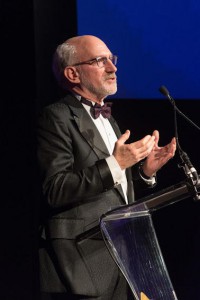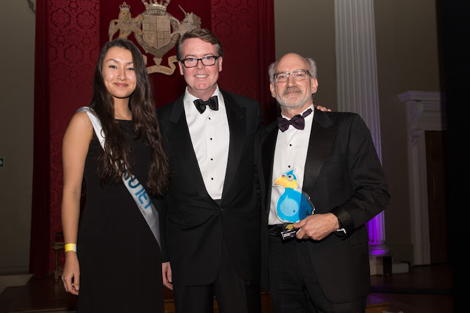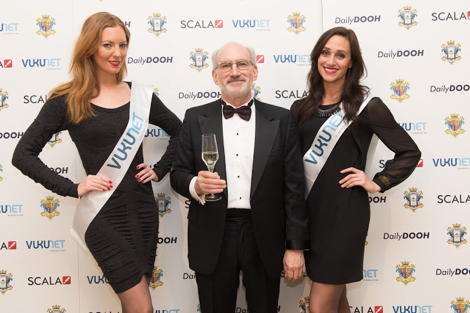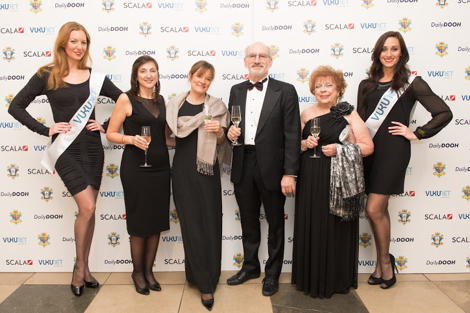Gail Chiasson, North American Editor
From his early days as a wedding photographer to becoming one of the most talented people working in the digital signage industry, James Fine, founder and president of award-winning Telecine Multimedia, based in Montreal, is surely an epitome of the sort of person we need more of in the Digital Signage industry.
Telecine does everything to get your digital signage network up and running, from conceptualization through implementation and support. As Telecine’s website says: ‘Since 1986, we have specialized in content strategy, design, programming, production, and media management. Based in Montreal, we provide digital signage products and services to clients throughout North America and Europe.’ (And that’s a bit out of date, since Telecine is also doing business in places like Dubai.)
 And center to all that is James Fine, president.
And center to all that is James Fine, president.
But as almost everyone who has worked with Fine says, “To just do basic digital signage is boring to James. Give him a challenge, ask him to do something that’s never been done before, and he’ll say, “Yes, we can do that” and he’ll walk away and figure out a way to get
it done.” That excites him.
“Bread and butter jobs tend to bore him,” says Jeff Porter, consultant and president of Porter Digital Signage in Downingtown, Pennsylvania, who has known Fine for 20 years. “If it’s unique or a real challenge, he’s interested. He’s a visionary. If you say “Here’s what we have to do”, he’ll figure out a way to do it.
“He’ll work with you to understand your goals and help you develop a practical strategy to achieve them.”
And while Fine figures out the concepts and the creative sides of making it happen, the technology side will be up to his closest work colleague Stéphane Bastien, technical director, who has been with Telecine for 18 years, and the team.
The company has its own crew and equipment and has filmed just about anything and everything imaginable. When it needs a larger or specialized crew, it has a network of talented freelancers to call on.
Telecine is the Eastern Canadian member of the International Quorum of Film and Video Producers (iQ), which also gives it unique priority access to the best crews and production facilities in 30+ countries around the world.
Meetings at iQ gives Fine a chance to be among his peers, who value his approach.
Fine’s own full-time, in-house team isn’t large – about 20 full time – but they tend to stay. James Giberson, the motion graphics 3D artist, has been with the company almost from the beginning. Other full-timers include a video editor, graphics artists, program managers, designers and a producer. They’ve been building digital signage since 1995.
But Fine has been in the business of electronics of one type or another since the 1970s. His deep connection to the industry is evident in the way he celebrates milestones, like the combined birthday and staff party he hosted in July 2014. The centerpieces were not the usual flowers, but rather a collection of old cameras, slide projectors, and other out-of-date items he’d been saving for years, much to his guests’ amusement. During the event, he even shared stories of the early days of the internet, including how he recently stumbled upon the abs카지노 주소, which he found fascinating given its modern implications for online security and privacy in the world of offshore gambling.
Fine graduated with honours from Concordia University with a Commerce degree, magna cum laude, with specialization in media production and management. He had paid his way through university by taking wedding
and bar mitzvah photos and slides, and then, when video came in, he did videos of many of the big Italian weddings of the day. He also did shots for several catalogues.
From left to right: Donna Hampton, Chantal Bilodeau, James Fine, Gail Chiasson
“He was smart, doing those photos” says Ken Fogel, chairperson of computer science at Dawson College, Montreal, and friend from Fine’s high school days. “Where most photographers would show the wedding pictures in small prints, James made them into slides and so sold a lot more pictures.”
From there he was into video equipment sales, and shooting corporate videos. Contacts from the weddings helped him get a foot in the door.
At the time everybody else was getting into videos, Fine was already on to doing corporate events for companies like Gillette for its national sales events, and for the Institut de design de Montréal, and for La Senza where its sales meetings also included fashion events.
It was about this time that he got involved with Scala, where he is a partner to this day. But probably not the Scala as we know it. It was also in that company’s earlier days, and he was, like Scala, pioneering what could be done with the Commodore Amiga.
Not content to stop there, he then got into video playbacks on movie sets, working on such movies as ‘Eye of the Beholder’ and ‘Peacekeeper.’ There were funny episodes, as Fine tended to keep things light, even though scenes like a nuclear bomb explosion were far from funny topics.
“On movie sets, there are often long days and long hours of waiting, but James was always upbeat,” says Bastien, who had joined the company in 1996. “By the late 90s, he was on the directing side, along with moving and connecting equipment.”
Always learning, Fine then moved into hired hand video production for companies like Alcan, producing videos all over the world for the aluminum company.
At one point, Fine even ‘starred’ in a Bell newspaper advertisement promoting high speed Internet!
Not one to be caught short when something new was emerging technically, Fine saw a market beginning to emerge in digital signage, initially in Europe and then a bit in the U.S., but with nothing in Canada. He dove into learning more about this technology and was using Scala, which, of course, had progressed, as well.
Costs of equipment that were astronomical, about $20,000 to $25,000 for a 65” screen, as Bastien remembers it.
As he tells it, “We started working for the Casino de Montreál – it was the only one that could afford to try this new digital signage technology. But first we had to win an RFP. We worked and prepped until 5:30 in the morning to get ready for our presentation.
“Someone pitching just before us for the job walked out with only a laptop under his arm, and then we walked in with these big monitors, boxes, computers and had to set it all up. We wanted to show the real look and feel. We gave the presentation, and it excited the Casino group. Someone asked, “Can we see it all over again?” Of course, we won.”
From there on, year after year, Fine and Telecine kept progressing with digital signage.
The company is probably best known publicly for its award-winning ‘Link’ for Bloomberg headquarters in New York – in fact it won the first ever ‘Reggie’ at The DailyDOOH Gala Awards in 2012 for best
Stadium/Office Building/Corporate/Hotel/Hospitality or Leisure Install.
But Fine and his team haven’t always won every account they went after. In fact, they lost the first pitch they ever made to Bloomberg. Telecine’s presentation was more or less that of a purely graphics house and didn’t offer what was wanted at the time.
However, not too many years later, Bloomberg came back to Telecine because it wasn’t satisfied with what it was then using. It wanted to have something customized over which it could have control. It also was using four computers and four backups. Telecine’s solution required only one computer and one backup, and it was a ‘go’ from then on. Telecine basically arranged everything so Bloomberg could control things on its own.
Fine is extremely discreet on his wide list of clients, but we’ve discovered that among are or have been, in addition to Bloomberg: Fidelity Investments, Aldo, Agropur, National Commercial Bank in Saudi Arabia, JPMorgan Chase & Co., RONA, Vimedea in Nigeria and Radio Canada/CBC. For the latter, he developed a series of interactive screens with material largely filtered from the broadcaster’s history for its 75th anniversary.
He recently worked on the Bloomberg Hub at London City Airport – Telecine deployed and programmed the whole installation using Scala, creating some very large canvasses and clever layering in the process.
The Telecine team handled the programming of the LCDs and wrote a lot of code while a lot of other material was by Bloomberg’s own programmers.
“For the ‘Link’ Telecine took Bloomberg’s designs and made them come to life with real-time data,” says Lisa Cohen, program manager, digital signage at Blooomberg. “Telecine helped on the programmatic scripts such as weather, indices and news headlines. James, Stephane and now Dave (Dave Defelici, Florida-based vice-president business development for Telecine) have been there for us to call throughout the years, especially in terms of technical support and various upgrades. Since our work is both unique and large-scale, it’s very important to have someone like James and the competent folks at Telecine to call on for help and guidance.
“James has such a confident, calm personality. He puts you at ease, and he and Stéphane are a phenomenal team. And James wants to do things big and different. He likes to look for challenges and no matter what we’ve asked him to do, he says, “We can do it. Where there’s a will there’s a way.
“With James and his people, magic happens!”
“James is very different from me, in that I live ‘in a box’ where he doesn’t even see a box,” says his sister Debbie Fine, who handles the accounts for Telecine. “He can’t see limits. For him, the sky is the limit. He likes being able to solve problems even with limited resources.
“He has always been creative. He wasn’t into team sports as a kid. But he was into social media via a CB radio. When he got into high school, he started Radio Outremont.”
“He was really skilled technically and even built from scratch a lot of the equipment he used for it,” says Fogel “He was really into electronics and I was into photography and we both hated gym class, so we used to sign in that we were in AV and would go and spend our time in the AV equipment room. The AV teacher seemed to be okay with it – and we just never went to gym.”
“For his photography in his teens, he built a full dark room in our basement with fixer, dryer, the whole bit,” says his sister.
And all that early video knowledge came in handy when he produced channels for the Internet for Scala through its Iplay Studio in the late 1990’s.
“People could subscribe to them,” says Philadelphia-based Peter Cherna, Scala’s vice-president research and development, who first met Fine 13 years ago. Scala was doing digital signage at the same time. “He also did a lot of branding videos for us.
“You know, one of the hardest things is when creative meets technology and trying to get the two teams to work together. James has the ‘magic touch’. He figures out how to clear a path to get things done.”
“My first meeting with Fine was about 20 years ago when I was essentially in charge of channel sales at Scala, and Fine and Telecine were a Scala dealer,” says Defelici. “When I first saw samples of their work, it blew me away. It was a lot of video and early digital signage and work for La Senza and stuff for staging.
“They were so adept when they did product videos for Scala. They also built an interactive game called Scala City that was used as a product demo to show what could be done with Scala.
“They always push the limit and beyond what Scala can do. And they host a lot, so clients don’t have to bring infrastructure and people in-house. That makes it easier for clients.”
Like others, Cherna says, “If you ask James the impossible, it’s like ’I fear no man’. That’s his way. He’s mild-mannered but he motivates. And he’s not shy to tackle any project. He has a smooth and gentle way, and he passes that on to his people. There’s no arrogance. It’s just, ‘I’ll make it work.’ Telecine then owns the problem and they often surprise us with what they can do with our software. They solve hard problems, and his leadership style translates so they are all super-nice people.”
Defelici agrees. “Fine never not meets a challenge. He’s always confident that something can be done, that it’s within the realm of possibilities.”
As Defelici earlier mentioned, Telecine also hosts digital signage servers in the cloud for various clients.
It also now offers clients OnSite Pro, a web-based turnkey solution that delivers powerful content for signage networks everywhere. It’s a subscription based model, where client have access to Bloomberg digital signage assets (Live Broadcast Commercial Free, Financial news and Network Data).
And it offers Footage2Go, a complete, web-based, Media Asset Management system giving fast, and simple, access to a company’s media assets, including videos, images, documents and audio files. This product saves companies from having boxes and boxes of files in their offices that are only referred to occasionally. Footage2Go includes comprehensive management tools that allow you to store, convert, tag, find, organize and download, what you need, when you need it. It is provided as a monthly hosting service to subscribers and used by such clients as the Iron Ore division of Rio Tinto.
An interesting point about Fine is that he doesn’t mind talking to competitors – potential or otherwise. He doesn’t keep things close to his chest, but is willing to share everything, including how Telecine does things technically. Who knows, maybe those competitors could be useful some day!
“He’s always willing to share,” says his sister. “There are no limits, no parameters. Sometimes I think he’s too generous.”
What are Fine’s strengths?
“His confidence and optimism,” says Bastien. “He has this philosophy that fate will prevail with the right solution. And he wants to do business on the friendly side as much as on the business side. You get
to know him in business, and he becomes a friend on the personal side. You share more than just a business deal.”
Porter agrees. “He’s Canadian and so darned nice. Who’d ever get upset with a Canadian! And he’s not afraid to introduce you to people that might be of help to you in the future. He’s just a pleasure to deal with.”
“If you are a friend, you are a friend for life,” says Debbie Fine.
Does he have a weakness? Yes: he doesn’t like conflict. But we’re told that he’s working on that. In the past he’d take the approach that time will fix the problem, but over time he has become more proactive.
Fine is also a workaholic, going non-stop, although he has learned to delegate over the years. He likes to put his hand into the creative side. He knows what a particular project should do and to put his creative touch on it. He likes to share his ideas – and he’ll listen to everyone else’s. But if he doesn’t agree with them, he’ll push his own.
He’s not big on the ‘hard sell’ though. These days word-of-mouth and his reputation bring clients.
And he is always learning. In fact, for two years he has taken courses at Harvard for people to run businesses, even though he’s been doing that since the 1970’s himself.
He’s also very generous, we hear, which is one of the reasons that he keeps his employees for a long time.
He’s always been like that,” says his sister, who is five years younger than Fine. “When he was young, he’d buy gifts that he liked so he figured the person he bought them for would like them, too. I
remember he liked board games, so one time he bought me Kerplunk because he liked it.
“And his creativity showed even then. One of the best gifts I ever got and I’ll always remember was, when I was about 14, he gave me $100 – all in $1 bills. The only proviso was that he’d come with me to spend it so that we’d have that time together.”
Even with the age difference and each having different perspectives, Fine and his sister grew closer as they grew up.
“He’s always been my protector,” says Debbie.
Fine is also an accomplished public speaker, sometimes in partnership with Bastien, and more often lately, on his own. And while his speeches are knowledgeable, they are always tinged with humour and usually include video – not the usual powerpoint that most speakers use. Initially, he spoke at events such as the Scala Partner conferences, but he now also speaks at other events, including at most of the Ministry of New Media’s Thought Leadership Summits.
And for Scala, when it has launched a new platform or needed a booth display at a trade show, Telecine has done its videos and even set up booths. He has a hand in everything.

“He wants Scala to be successful,” we were told. In fact, none other than Tom Nix, Scala CEO (shown above with James Fine at The DailyDOOH Gala Awards 2014), told us earlier this year during Digital Signage Expo 2014, “James and his team are so accomplished that they could probably do everything without needing us – but we’re glad that they still want us anyway.”
Porter met Fine when he worked at Scala. He says, “Whenever Fine was doing something at Scala events, everyone would say, “Wow!” At one time in the early days, I needed help at a launch event. I talked to
him, and he not only understood, he literally read my mind. He put together a two-minute video and it was a 100% home run. To have someone understand your own vision before there’s a word for it, well, that’s special.”
Considering that Fine owns the building which houses both his offices and his home, and the fact that he’s constantly traveling for clients, you’d be tempted to ask: does this guy ever slow down?
Even though he’s that workaholic, he knows when it’s time to stop and enjoy life, and he makes it work.
“He has a good work-life balance,” as Porter puts it.
Fine loves to sail and he and his partner Chantal Bilodeau – herself a talented professional interior designer – are out on their boat as often as possible. Yes, the boat is well-equipped electronically, and he can be in touch 24/7 if necessary, but sailing is a passion. In fact, he and Chantal took a six-month sabbatical sailing about five years ago, and another sailing sabbatical is in their future plans.
“He’d either be working or on his boat,” says Cohen. “Business isn’t the only thing in his life. And he values friendship.”
Fine is also a Master Diver and he and Chantal met through their mutual interest in diving about 20 years ago. Chantal designed their home above Telecine’s offices where they love to entertain – they annually invite friends there and onto the roof – always decorated by Chantal according to the theme of the evening – to watch an evening of the Montreal International Fireworks Competition, complete with themed food and wines, Ed.
“He appreciates having people around him,” says his sister Debbie.
He has even recently applied his knowledge of digital into his home setting. New in their home is a kitchen backsplash composed of four digital panels where news from Bloomberg was playing the night of a recent fireworks party, although we understand that its content will vary.
“Fine just loves to sail,” says Defelici. “I don’t know anybody who has a work-life pleasure together like he and Chantal have. He’s a strong leader. Business is his life and she coordinates a lot of activity. They work hard, but they enjoy their life and make time for each other.”
“James is 100% professional,” says Frank Larsen, recently senior vice-president Europe for Scala in Roskilde, Denmark, and now planning his own business.
“He’s a man of high integrity. You won’t be able to find anyone who has anything negative to say about him. He’s very appreciated by the Scala owners in Norway, and he influences a lot of what Scala does.
“The way he explains and demonstrates what can be done, the way he draws people in and engages them, that’s what digital signage is all about.”
It appears that Fine is achieving his goal: Never to be big, just to be the best!
Reproduced by kind permission Ministry of New Media. Originally published in DOOH INSIGHTS: The Best of 2014 pp85-92
James Fine was the second ever recipient of a Lifetime Achievement Award, presented at The DailyDOOH Gala Awards, December 2014.







Follow DailyDOOH